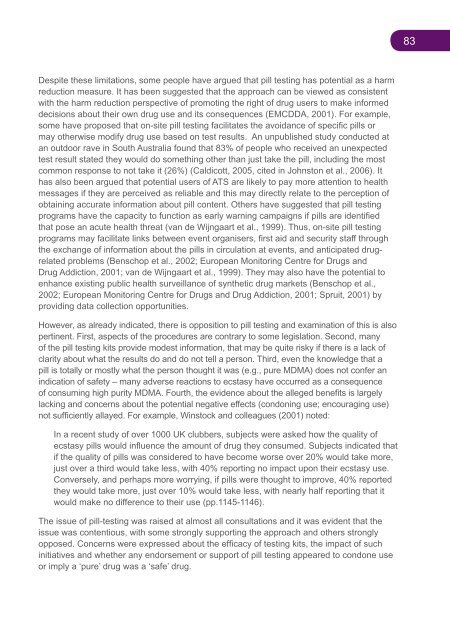National Amphetamine-Type Stimulant Strategy Background Paper
National Amphetamine-Type Stimulant Strategy Background Paper
National Amphetamine-Type Stimulant Strategy Background Paper
You also want an ePaper? Increase the reach of your titles
YUMPU automatically turns print PDFs into web optimized ePapers that Google loves.
83<br />
Despite these limitations, some people have argued that pill testing has potential as a harm<br />
reduction measure. It has been suggested that the approach can be viewed as consistent<br />
with the harm reduction perspective of promoting the right of drug users to make informed<br />
decisions about their own drug use and its consequences (EMCDDA, 2001). For example,<br />
some have proposed that on-site pill testing facilitates the avoidance of specific pills or<br />
may otherwise modify drug use based on test results. An unpublished study conducted at<br />
an outdoor rave in South Australia found that 83% of people who received an unexpected<br />
test result stated they would do something other than just take the pill, including the most<br />
common response to not take it (26%) (Caldicott, 2005, cited in Johnston et al., 2006). It<br />
has also been argued that potential users of ATS are likely to pay more attention to health<br />
messages if they are perceived as reliable and this may directly relate to the perception of<br />
obtaining accurate information about pill content. Others have suggested that pill testing<br />
programs have the capacity to function as early warning campaigns if pills are identified<br />
that pose an acute health threat (van de Wijngaart et al., 1999). Thus, on-site pill testing<br />
programs may facilitate links between event organisers, first aid and security staff through<br />
the exchange of information about the pills in circulation at events, and anticipated drugrelated<br />
problems (Benschop et al., 2002; European Monitoring Centre for Drugs and<br />
Drug Addiction, 2001; van de Wijngaart et al., 1999). They may also have the potential to<br />
enhance existing public health surveillance of synthetic drug markets (Benschop et al.,<br />
2002; European Monitoring Centre for Drugs and Drug Addiction, 2001; Spruit, 2001) by<br />
providing data collection opportunities.<br />
However, as already indicated, there is opposition to pill testing and examination of this is also<br />
pertinent. First, aspects of the procedures are contrary to some legislation. Second, many<br />
of the pill testing kits provide modest information, that may be quite risky if there is a lack of<br />
clarity about what the results do and do not tell a person. Third, even the knowledge that a<br />
pill is totally or mostly what the person thought it was (e.g., pure MDMA) does not confer an<br />
indication of safety – many adverse reactions to ecstasy have occurred as a consequence<br />
of consuming high purity MDMA. Fourth, the evidence about the alleged benefits is largely<br />
lacking and concerns about the potential negative effects (condoning use; encouraging use)<br />
not sufficiently allayed. For example, Winstock and colleagues (2001) noted:<br />
In a recent study of over 1000 UK clubbers, subjects were asked how the quality of<br />
ecstasy pills would influence the amount of drug they consumed. Subjects indicated that<br />
if the quality of pills was considered to have become worse over 20% would take more,<br />
just over a third would take less, with 40% reporting no impact upon their ecstasy use.<br />
Conversely, and perhaps more worrying, if pills were thought to improve, 40% reported<br />
they would take more, just over 10% would take less, with nearly half reporting that it<br />
would make no difference to their use (pp.1145-1146).<br />
The issue of pill-testing was raised at almost all consultations and it was evident that the<br />
issue was contentious, with some strongly supporting the approach and others strongly<br />
opposed. Concerns were expressed about the efficacy of testing kits, the impact of such<br />
initiatives and whether any endorsement or support of pill testing appeared to condone use<br />
or imply a ‘pure’ drug was a ‘safe’ drug.

















